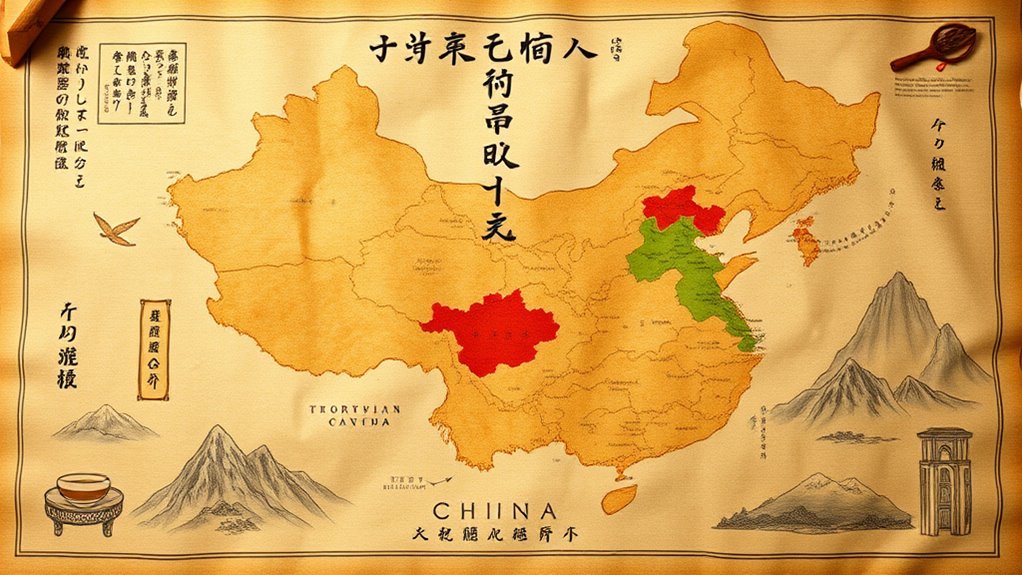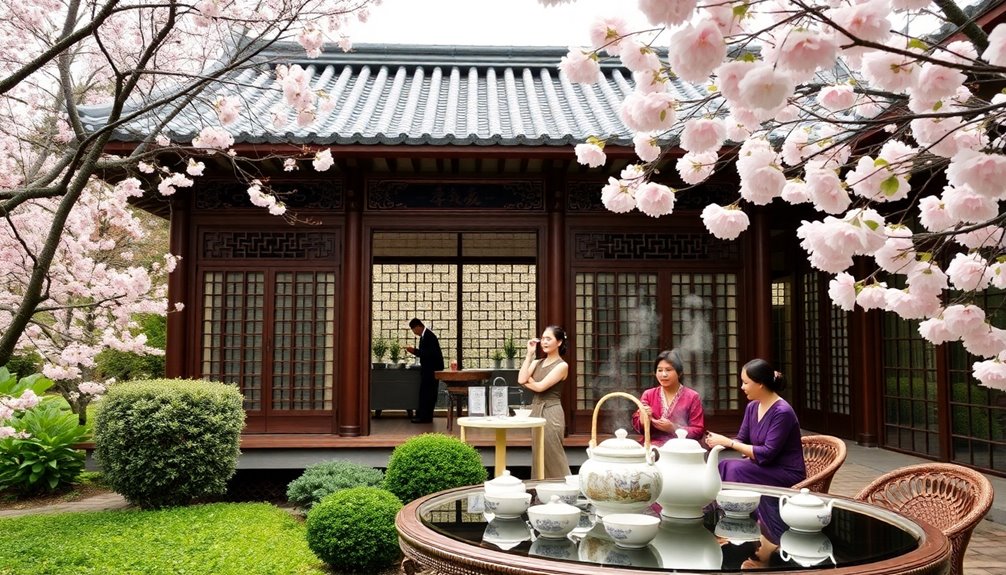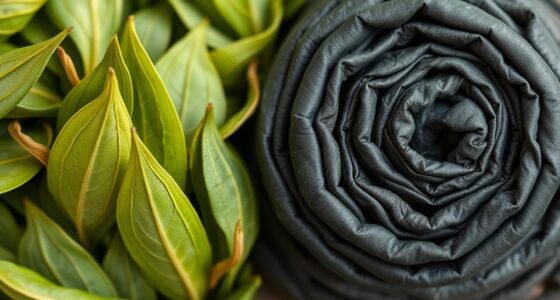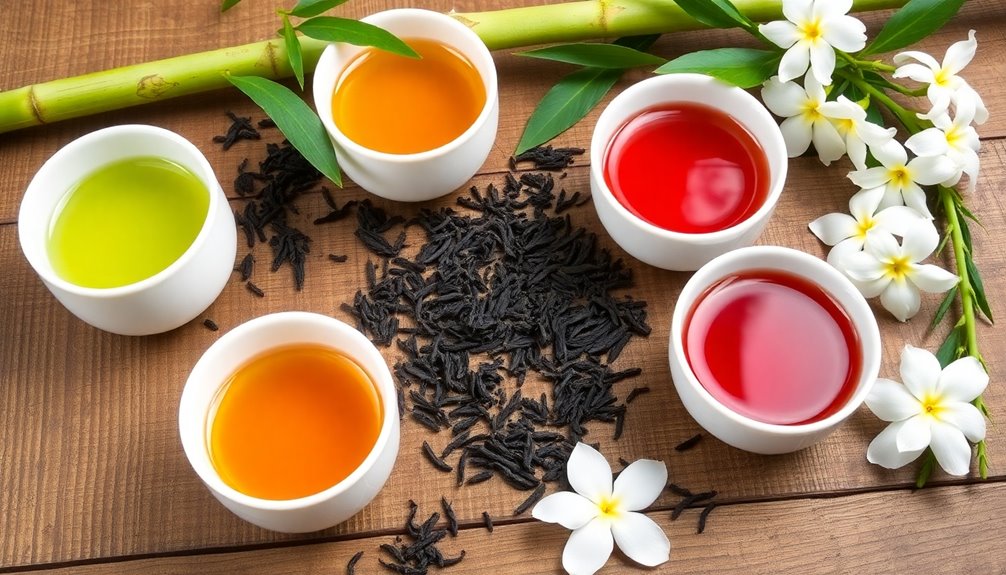Discover how China’s top ten teas are shaped by their unique terroirs—climate, soil, and elevation influence flavor and aroma. From the cool, mineral-rich environment of Longjing to the earthy notes of Pu-erh in Yunnan, each region’s geography creates distinctive tastes. Understanding these terroirs helps you appreciate the rich diversity behind each cup. Keep exploring to uncover how environment and craftsmanship together craft these signature flavors.
Key Takeaways
- China’s ten famous teas each have distinct terroirs shaped by climate, soil, and elevation, influencing their unique flavors.
- Regional variations in cultivation and processing techniques create signature taste profiles for each famous tea.
- High-altitude and mineral-rich soils contribute nuanced, complex flavors in teas like Longjing and Tieguanyin.
- Terroir knowledge enhances appreciation by revealing the environmental and cultural origins behind each tea’s character.
- A terroir tasting map visually connects China’s regions with their iconic teas, highlighting environmental influences on flavor.

Have you ever wondered how the unique taste of a wine or coffee is shaped by its origin? The same principle applies to tea, where terroir plays a essential role in creating distinctive flavor profiles. When exploring China’s famous teas, understanding tea cultivation and how it interacts with the local environment helps you appreciate why each tea offers a different sensory experience. From the misty mountains to the lush valleys, the conditions in which tea plants grow influence everything from aroma to aftertaste.
In China, tea cultivation varies widely across regions, with climate, soil, elevation, and craftsmanship all contributing to the final product. For example, green teas like Longjing from Hangzhou benefit from the cool, humid climate and mineral-rich soil, imparting a nutty, slightly sweet flavor. Meanwhile, Yunnan’s Pu-erh tea thrives in a warm, damp environment, which adds earthy, complex notes that deepen with age. These variations in terroir help shape the flavor profiles that define each region’s signature tea.
As you taste different teas, think of how the environment influences each sip. Tea grown in high-altitude areas often develops more nuanced flavors because the cooler temperatures slow growth, allowing for more complex chemical development. Conversely, tea from lower elevations tends to be bolder and more robust. The soil composition—whether it’s volcanic, clay, or mineral-rich—also impacts the taste, adding layers of depth that reflect the land’s unique characteristics. This connection between land and flavor makes each cup a story of its origin.
You’ll notice that Chinese teas often carry a sense of place, a reflection of their terroir. For instance, the fragrant, floral notes of Fujian’s Tieguanyin are influenced by the subtropical climate and specific cultivation methods. Similarly, the smoky, toasted qualities of certain teas from Sichuan are tied to traditional processing techniques suited to the local environment. These regional distinctions aren’t just about tradition—they’re about how nature and craftsmanship come together to produce a truly unique sensory experience.
Chinese teas embody terroir, blending nature and craftsmanship for uniquely expressive flavors rooted in their native landscapes.
Additionally, understanding the interplay of terroir and processing techniques enriches your appreciation of each tea’s complexity. Recognizing how environmental factors combine with human craftsmanship helps you grasp why each region’s teas are distinct and special.
Understanding the relationship between tea cultivation and flavor profiles enhances your tasting journey. Instead of simply drinking tea, you begin to explore its origin story, appreciating the land, climate, and effort behind each leaf. This awareness deepens your connection with each sip, making tea tasting more meaningful. Whether you’re an enthusiast or a casual drinker, recognizing how terroir influences Chinese teas helps you savor their complexity and appreciate the artistry rooted in a particular place.
Frequently Asked Questions
How Does Climate Influence Tea Flavor Profiles?
Climate profoundly influences tea flavor profiles by affecting soil minerals and altitude influence. You’ll notice that warmer climates often produce bolder, more robust teas, while cooler, higher-altitude regions yield teas with delicate, nuanced flavors. The soil minerals in different climates add unique tastes, and altitude influence enhances the complexity. So, when you taste tea, remember that climate shapes its aroma, body, and overall character, making each region’s tea distinct.
What Are the Best Storage Methods for Chinese Teas?
Imagine your tea as a delicate treasure, needing a safe haven. Store it in a airtight tea container to keep out moisture and odors, symbolizing a fortress guarding its purity. Keep the storage temperature cool and consistent, like a calm mountain stream, to preserve flavor. Avoid sunlight and strong smells, which act as thieves stealing its essence. Proper storage guarantees your tea remains vibrant and aromatic over time.
Can Terroir Impact the Health Benefits of Tea?
Terroir can definitely impact the health benefits of tea. You might notice that soil mineral content influences the antioxidants and nutrients in the leaves, while cultivation altitude affects the concentration of beneficial compounds. When you choose teas from different regions, these factors can alter how your body absorbs antioxidants or other health-promoting elements. So, understanding terroir helps you select teas that maximize health benefits based on where and how they’re grown.
How Do Traditional Chinese Processing Techniques Vary by Region?
You’ll find that traditional Chinese processing techniques differ across regions due to local climate, culture, and tea varieties. These regional variations influence how teas are withered, rolled, oxidized, and fired. For example, Fujian’s oolong processing involves specific rolling and oxidation steps, while Yunnan’s pu-erh undergoes unique fermentation. These regional differences in processing methods give each tea its distinct flavor profile and character.
Are There Seasonal Differences in Tea Taste Within Each Region?
Imagine your favorite song changing with the seasons—that’s how tea tastes shift throughout the year. You’ll notice seasonal flavor variations that bring out new nuances, making each sip a fresh adventure. Regional taste shifts deepen this experience, as climate and harvest times influence the tea’s character. So, yes, within each region, you’ll find a dynamic dance of flavors that evolve as the seasons turn, enriching your tea journey.
Conclusion
As you explore China’s ten famous teas, remember that terroir shapes their unique flavors just as it shapes the land itself. While each sip offers a glimpse into a specific region’s soil, climate, and tradition, it also reminds you that beauty and complexity often emerge from contrast—harsh winters and lush springs, ancient roots and modern hands. Embrace these differences; they’re what make each tea a story worth tasting and a world waiting to be discovered.










